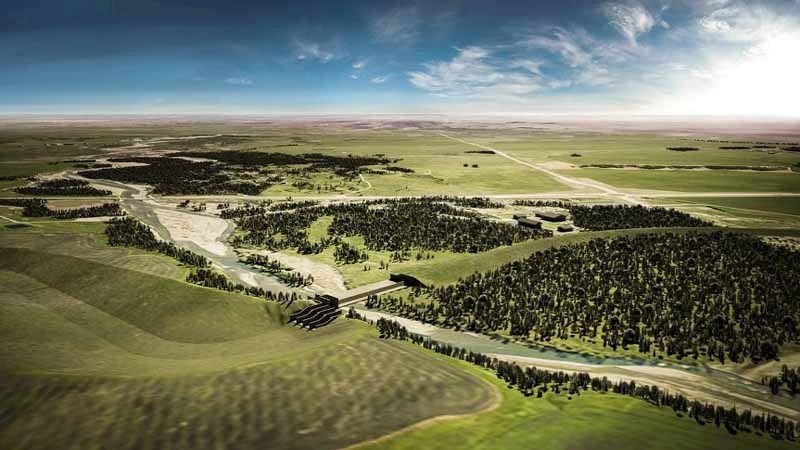St. Patrick’s Island near the confluence of the Elbow and Bow rivers in Calgary was the setting for a May 9 press conference that marked the start of construction for the Springbank Off-Stream Reservoir Project (SR-1).
Set to cost a total of $744 million, SR-1 is one of the largest provincially funded infrastructure projects in the province’s history. It is the flagship for Alberta’s flood mitigation efforts in the wake of devastating floods nine years ago.
St. Patrick’s Island was at the centre of the 2013 floods that devastated many inner-city Calgary neighbourhoods as well as some of Calgary’s surrounding communities along the Elbow River, including Bragg Creek and Redwood Meadows.
“As we know, back in 2013, a catastrophic flood developed, and this was the very heart of it,” said Premier Jason Kenney, who was joined at the event by several other Alberta government ministers and officials. “[It was] a flood that caused more damage than any other flood in Canadian history – $5 billion of damage that destroyed an enormous amount of property and disrupted people’s lives in Calgary and surrounding areas for weeks. We know it was a once-in-a-century flood, but we must be prepared for the next major flood to prevent damage of that scale.”
During his remarks, Kenney discussed the public interest of SR-1 – a dry-dam reservoir that, once complete, will temporarily divert and store 78 million cubic metres of floodwater from the Elbow River during an extreme flooding event before releasing it back into the river.
The Alberta government first proposed the project in 2014. The project received provincial and federal regulatory approval in 2021. Vinci Infrastructure Construction Ltd. won the contract to build the reservoir.
Construction is taking place in Rocky View County, north of Highway 8 and east of Highway 22. Partial completion is scheduled for 2024, with full completion by 2025.
The project will create 2,200 jobs and create a reservoir area of approximately 3,700 acres, Kenney said.
But the cost of the project has risen to $744 million since it was first proposed. Kenney noted that $576 million will be paid for by the provincial government. He added that the province’s 2022 budget confirmed a $473 million capital investment for the SR-1 project over the next two years.
“This is one of the largest infrastructure projects ever undertaken in the province funded primarily by the Government of Alberta,” he said. “I know Calgarians, particularly in the flood zone, have been anxious and waiting for this project to get underway.”
But the project has received pushback from many Springbank residents since it was first proposed in 2014. The Springbank Community Association has been a vocal opponent for years, touting another location for a flood mitigation reservoir further upstream at McLean Creek as a less disruptive alternative.
Other opponents originally included Rocky View County, Tsuutʼina Nation, and Don't Damn Springbank – a grassroots group of area residents that formed to challenge the project, and suggest alternative options for flood relief. Tsuutʼina Nation and RVC both withdrew their formal opposition in the spring of 2020, receiving millions in financial compensation as a result.
In previous interviews with Great West Media, Springbank Community Association president Karin Hunter brought up issues landowners expressed about SR-1’s potential environmental impacts and air quality concerns, as well as the government's lack of transparency and the rising cost of the project.
“We remain concerned, and we’re disappointed that it’s moving forward,” she said in a November 2021 interview. “But the government had its full weight behind the project since day one, and so it’s a difficult situation to be in.”
Municipal Affairs Ric McIver was among the provincial ministers present May 5. He called SR-1 “the right project,” adding three separate provincial governments have been in favour of it over the last eight years.
“The PC government picked this project after doing great research two governments ago,” he said. “The former NDP government was elected on a promise to not build Springbank but build something else. But once confronted with the facts after they were in government, decided this was the right project.
“Our government, with a fresh look at it because we were a new government, looked at it hard to make sure. I feel really good about the fact this is the right project. It’s been confirmed by three different governments of three different stripes.”
While the province maintains that all land acquisitions required for the project were voluntary, with no expropriations required, Hunter told Great West Media last fall that many landowners sold feeling there was little alternative.
“The pressure of the government and threat of expropriation is significant and hard to combat,” she said.



